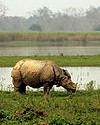Oasis in a desert
A desert traveler is so very happy at the sight of a palm tree at a distance. Because the palm tree signals the existence of what is called an oasis. Oasis is a small patch of vegetation surrounded by the desert, a piece of ‘green’ land in an otherwise very barren land. Oases exist in deserts of Africa, Asia, North and South America and the Middle East. There are about 90 or more oases in the world’s largest Sahara desert.
Oases exist because of the presence of groundwater even in the driest desert. They are formed from underground rivers or aquifers where water can reach the surface naturally by pressure or by man-made wells. People occupying the oases tap the underlying water source preserving access to it. They use the scanty supply of water to irrigate date palms, apricots, figs, olives and other crops. Vegetation could also be grown due to the migrating birds which halt on the sight of water and pass seeds with their droppings.
Rivers that may flow from highlands into the desert also supports oases in the form of ribbons of greenery along the banks. There is always a possibility of sandstorms in the desert which may pollute the water and agriculture. That is the main reason for planting strong trees around the oases. These trees keep the desert sands away from the delicate crops and water of the oasis.
Oases in the Sahara and other places are not only a piece of greenery for its occupants but also are important centers of trade. Traders passing via stop here for food and water. Al-Hasa, an oasis in Saudi is today one of the leading agricultural regions producing dates, corn, sheep, cattle and eggs. As it lies in the belt of richest oil fields in the world, it has become an important place for international trade.
How is an aurora (northern light) formed?
Why is cacao important?









